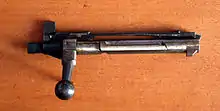Push feed and controlled feed
Push feed and controlled feed (or controlled round feed) are two main types of mechanisms used in firearms to describe how the bolt drives the cartridge into the chamber and extracts the spent casing after firing.
- The push feed system does not grip the base of the cartridge before the cartridge has been fully entered into the chamber, and therefore under normal operation requires the cartridge to be fully chambered before it can be extracted.[1]
- The controlled feed system grips the base of the cartridge with the extractor claw before the cartridge is stripped from the magazine,[2] and therefore makes it possible to extract the cartridge before it has been fully chambered.


Which of the two systems is the "best" has been debated for over 50 years,[3] and both systems have their strengths and weaknesses. Some prefer the controlled round feed for hunting on dangerous game, while others state that either of the systems can be reliable or unreliable,[4] depending for example on the quality of the rifle and maintenance. There has been a trend that newer rifle models tend to have a push feed mechanism, while almost every modern semi-auto pistol has a controlled round feed. A push feed system is in most cases cheaper to manufacture.
History
The first rifle with a controlled feeding mechanism was the M1885 Remington–Lee which first appeared in 1879.[5] Lee applied for a patent (US221328[6]), around the same time as Mauser applied for a patent on the same feature (DE51241[7] and US476290[8]) which was introduced on the Mauser Model 1893.
Discussion
Double feed
The main disadvantage with a push feed system is the possibility for a double feed malfunction if the bolt is not fully closed when chambering a round, followed with pulling the bolt back to strip another round from the magazine, resulting in one chambered and one partially chambered round. A double feed in itself is somewhat uncommon as an independent malfunction, but it often manifests itself as a consequence of other firearm malfunctions. A controlled feed mechanism should in theory not be able to double feed if it is set up correctly.
Safety during case rupture
Push feed mechanismens in theory give the opportunity to design a safer firearm when it comes to a case rupture (for example due to overpressure or excessive headspace) since the bolt head can be designed with a smaller extractor claw which in turn gives the rest of the bolt head a bigger surface are and therefore better support for the cartridge during firing.
Ejector types
Most push feed mechanisms use a spring loaded plunger type of ejector situated at the breech face, and this system ejects the spent casing as soon as the case mouth clears the ejection port.[9] Most controlled feed mechanisms use a fixed mechanical ejector attached to the receiver, which results in the bolt having to be pulled all the way back to eject the spent casing. This can give a marginally quicker cyclic rate with a push feed action, since the bolt no longer has to be repeated all the way as far back.[10]
Hand feeding directly into the chamber
Most controlled feed mechanisms should not be closed on a chamber already containing a cartridge (similar to how a push feed mechanism would operate). On short term this can result in difficulties with closing the bolt, and therefore also difficulties with extracting the unfired cartridge from the chamber. On long term, the extractor may be damaged or take significant wear if so is done, since the extractor claw on most controlled feed mechanisms has not been designed to slip over the rim of a chambered round. As a result, controlled feed mechanisms should always be fed with cartridges which first have been filled into the magazine.[11]
Push feed mechanisms on the other hand have extractor which are designed to move around the rim of an already chambered round, and cartridges can therefore either be fed via the magazine or hand fed directly into the chamber (sometimes called "single loading").
Examples of firearms with controlled feed mechanisms
- Mauser M98
- Winchester Model 70 (pre-1964)
- Sako 85
- M1911 pistol[12]
Examples of firearms with push feed mechanisms
See also
References
- Controlled Feed vs. Push Feed Rifles - What's the Difference?
- Bolt-Action Rifles: Push Feed Vs. Controlled Feed | Gun Digest
- American Hunter | Bolt-Action Rifles: Push-Feed vs. Controlled-Round-Feed
- Controlled Round vs. Push Feed: What’s the Best Rifle Practice? – Tactical Life Gun Magazine: Gun News and Gun Reviews
- Five Supposed Mauser Firsts ... That Weren't -The Firearm Blog
- US221328A - Improvement in magazine fire-arms - Google Patents
- Espacenet - Original document: DE51241 (C)
- US476290A - Paul mauser - Google Patents
- Controlled Round Feed Rifles vs Push Feed Rifles
- How Does It Work: Push Feed vs Controlled Feed – Forgotten Weapons
- Bolt Actions: Controlled Feed or Push Feed?
- 1911 Controlled FeedRange Hot